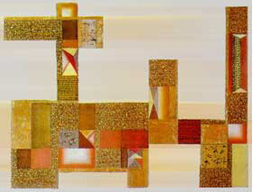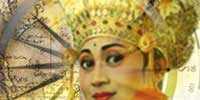|
DENPASAR (indo.com): As Putu Wirata Dwikora explained, the
tradition of a single, dominant style of Balinese painting
is slowly disappearing, as the local art world accommodates
a variety of styles in local culture and society.
Like it or not, Balinese art is undergoing significant change.
Those who were once part of the mainstream are now finding
themselves faced with a multiplicity of views and varied
lifestyles - a reality with which sponsors of Balinese art
have been facing for the past five years.
For more than a quarter of a century, art critics and commentators
of Balinese art could barely avoid mentioning Sanggar Dewata
Indonesia - the association of Balinese artists who had
studied at Yogyakarta's Art Institute - as a reference and
a barometer for the development of contemporary Balinese
art. Sanggar Dewata was established in Yogyakarta in the
1970's by Nyoman Gunarsa, Made Wianta, Pande Supada and
Wayan Arsana.
Nyoman Gunarsa, with his sketches around the theme of death,
drew on Balinese offerings, and thereafter on Balinese dancers
and the Kamasan shadow puppets, for inspiration for his
paintings. Gunarsa used a 'western' method that he had learnt
at Art school. Recently, Nyoman Erawan has emerged, with
his Hindu-Balinese icons and experiments with Hindu philosophy
to enhance appreciation of his work.
The emergence of Balinese tradition in contemporary visual
media began in the early 1980s. It exploded thereafter,
resonating for another 25 years, and spawning the likes
of Erawan and his numerous works, each of which has proven
that he is serious about an expressive form that is true
to him. Poleng (black and white checks), Chinese coins,
cakra circles, temples, offerings and the use of strongly
contrasting colors, have been central features of the young
Balinese artists to emerge over the last 25 years. Many
of them have reconstituted familiar themes such as the crematorial
fire, the barong dance, rangda, masks, the baris dance,
rejang dance and the like.
 |
|
| Reconstructing
(1995); acrylic on canvas by Made Wianta |
|
This specifically Balinese Hindu abstract expressionism
represented a phenomenal challenge to the collective culture
of Bali, itself extremely strong. Up until the emergence
of the contemporary Sanggar Dewata Indonesia in the nineteen
seventies, Balinese painting was dominated by a traditional
agrarian style which was a remnant of the Klungkung kingdom
and was exemplified by the Kamasan Wayang style of Klungkung,
the Ubud and Batuan styles, and so forth. Up until the formation
of the Pita Maha in the 1950s, by Rudolf Bonnet, Spies and
Tjokorde Gde Agung Sukawati, innovations in painting were
bound by the frame of traditional limitations. Prior to
the Pita Maha, painting was understood as a form of prayer,
if not to the Gods, then to the local palace, perceived
as an embodiment of the holy. Artists would thus labor at
the palace to demonstrate their loyalty to the king, or
work at the temple to demonstrate their loyalty to the religious
community. The late Gusti Ketut Kobot, a wayang painter
from Pengosekan, Ubud, remembered his happy childhood years,
helping to paint the ritual cloth in the Ubud Palace. "I
am really grateful to have had that opportunity. The palace
only paid us in food which we ate while working," he said.
The theme of these traditional Ubud paintings was around
the wayang, including stories of the gods and popular folk
stories. Most importantly, this art was an expression of
the community. Artists never signed their work, and they
were always proud if their students copied their work. To
have their work imitated meant they had attained the status
of a guru, the highest honor for a Balinese.
Following the loss of its mentor, Walter Spies, in 1942,
who was killed when the ship he was traveling on was bombed
by the Japanese, and the return of Rudolf Bonnet to Holland,
the Pita Maha association broke up. But the collective spirit
embodied by the organization did not die, for its artists,
such as Gusti Ketut Kobot, Anak Agung Gde Sobrat, Ida Bagus
Made, among others continued the Pita Maha tradition. In
fact, the Pita Maha's influence remains evident in a number
of young artists today. Wiranata, for example, displays
Spies influence in his very poetic paintings of Balinese
landscapes, which depict the rays of the dawn light touching
on foliage and the bodies of farmers in their rice paddies.
After the Pita Maha period, in the 1950s and 1960s, a na´ve
style emerged, and was heavily influenced by the Dutch painter
Arie Smit. This style became known as the Young Artists
style, and made use of primary colors, strong contours and
heavy strokes to depict the human form and other objects.
Based in Penestanan, a village in the Ubud area, the Pengosekan
style, which featured close-up depictions of birds and leaves,
and also contained collective nuances, emerged too during
this period.
Wherever we look, therefore, we see a community of artists
whose works display a collective spirit from the point of
view of theme, technique and even use of color. This collective
spirit can be read as an expression of the collective will
embodies in the banjar, the smallest community unit in Bali,
which ties together the religious, traditional and emotional
affiliations of the community.
This collective nuance has thus become a kind of mainstream
within the local art world, the point from which local artists
depart and the point at which they converge. It is also
the cause for lack of change and innovation among Balinese
painters. Ida Bagus Made, Gusti Ketut Kobot, Anak Agung
Gde Sobrat, Ngurah Kresna Kepakisan, Made Meja, and others,
have remained loyal to their collective styles, in spite
of the input of scores of foreign artists from Java, Lombok,
Europe and America upon their works. Together, they have
held to a single value that has been responsible for their
style.
| |
|
| |
Pitamaha's
member in Puri Saren, Ubud. |
Towards the end of the 1970s, Professor Ida Bagus Mantra,
a local academic and cultural critic who became governor
in 1979, introduced the idea of holding the Balinese Arts
Festival. A graduate of India's Chanti Niketan University,
Mantra's idea was to use the Festival as an important step
in the process of seeking the Balinese identity, feared
by many as endangered in the face of the island's growing
tourism industry. Many Balinese, it was argued were influenced
by the culture of the tourists who came from afar to holiday
in Bali often only for just a few weeks. Dr Agung Made Jelantik
remembers how, in the 1970s, as increasing numbers of young
Balinese wore their hair long and listened to rock or pop
music, gamelan sets on the island were rapidly disappearing.
One instrument, the gong gede, was practically non-existent
on the island, and pop music cassettes were becoming an
increasingly predominant phenomenon, according to Jelantik,
and pop songs were beginning to be played in preference
to local music at ritual events.
Young Balinese who had undertaken their education at the
Yogyakarta Arts Institute, such as Made Wianta, Nyoman Gunarsa,
Pande Supada, Wayan Sika, Arsana, Nyoman Erawan, Made Djirna,
Made Budhiana, and others, found themselves in an artistic
dilemma. The discourse of Balinese-ness among Balinese people
had escalated to the level of polemic, which continued for
five years from the beginning of the 1980s. What people
feared was the loss of the philosophical underpinnings of
the Balinese identity, and the specter of Bali becoming
no more than the cultural ruins of a spiritless people,
reduced to being the servants of tourism.
During Mantra's period as Governor, Denpasar's Udayana University
began offering a visual arts study program. The PSSRD (Program
Studi Seni Rupa dan Desain: Program for the Study of Art
and Design) served as a kind of gatekeeper for the preservation
of tradition. Both Prof. Rai Kalam and Drs. Gung Wayan Cidera,
graduates of the esteemed Bandung Institute of Technology,
and a number of other lecturers, upheld local artistic traditions
by presenting them to students relatively free of scholarly
interpretation.
The collective expressions of the Pita Maha, Batuan, Young
Artists, Pengosekan and Kamasan Klungkung schools continued
with few changes, in spite of the fact that foreign artists
continued to come to the island and settle around Ubud.
Artists such as Affandi, Abdul Aziz, Srihadi, Arie Smit,
Antonio Blanco, were among those who migrated to the Ubud
area, bringing with them styles that differed vastly from
those of the local Balinese. The seemingly impervious nature
of local painting traditions may well have been a form of
local resistance to foreign intervention. The late Ida Bagus
Made said, for example, that the styles and themes to which
his paintings refer make them as valid and as important
as works from other places in the world.
Such personal conviction, such belief in their Balinese-ness,
is also evident among the artists of Sanggar Dewata Indonesia.
In that context, these artists are not content with being
merely the inheritors of a great tradition.
This Sanggar Dewata style has now become the dominant style,
the barometer, of contemporary Balinese painting, and it
is this style that is emerging most visibly in Bali's art
schools today. For more than quarter of a century, therefore,
the Sanggar Dewata style has attracted much attention. What
is it about abstract expressionism that has made it so popular
among art students and gallery owners and curators? Does
it possibly represent the Balinese neo-collective, the collective
that finds social expression in the banjar? It could also
be read as a form of social resistance from those who are
opposed to foreign intervention via the overwhelming power
of the electronic media, or via the growing tourism industry.
In spite of the predominance of the Sanggar Dewata style,
younger artists are now beginning to express their own challenges
to the SDI position. Why must every work of art refer to
the Balinese essence? And what are the relevancies and the
implications of that essence for day-to-day life, in particular
in the realm of art? At the root of the will to strengthen
the Balinese spirit, is cultural resistance. The tourism
industry, since its beginning in the 70s, has had certain
implications in terms of changing the ethnic make-up of
the island, its culture and even its economy. The social
space of Balinese communities has undergone significant
change, such that everywhere there are Balinese who feel
the specter of alienation from their own culture. Architecture,
ways of dressing, cuisine and also ways of communicating,
to name a few, has undergone immense change. Bali is currently
experiencing culture shock.
So, it is understandable that contemporary Balinese artists
are concerned about maintaining the essentials of their
own culture. And that concern is present in the paintings
of the Sanggar Dewata artists and their influence on contemporary
Balinese painting to this day. This movement, this collective
aim on the part of young Balinese artists to preserve Balinese
identity, has moved into the mainstream.
*This article is taken from Bali Echo.
|







